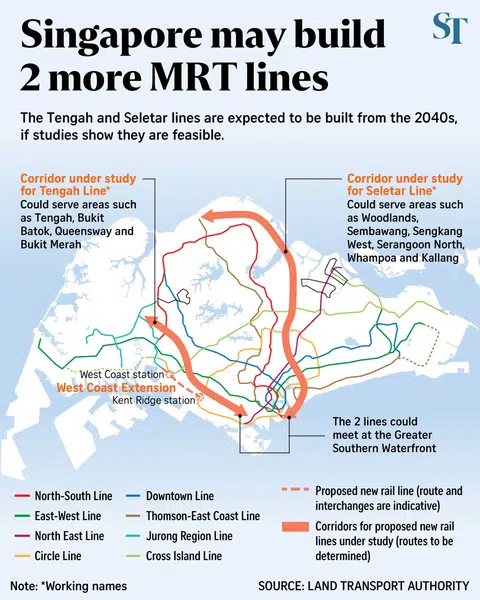Two new MRT lines - tentatively called Tengah and Seletar - under study
A potential new rail line that could serve areas in Singapore's west and north-west, such as Tengah, Bukit Batok, Queensway and Bukit Merah, is being studied for its feasibility.
Tentatively called the Tengah Line, it is one of two possible MRT lines that the Government is looking to build as part of the next bound of its rail expansion.
Transport Minister Chee Hong Tat laid out these plans during the debate on his ministry's budget on March 5.
The other potential rail line, tentatively called the Seletar Line, has been under study since 2019.
Running from Woodlands to the future Greater Southern Waterfront, it could serve areas such as Sembawang, Sengkang West, Serangoon North, Whampoa and Kallang. "I hope it could also go through some parts of Toa Payoh," Mr Chee added.
He said early assessments by the Land Transport Authority (LTA) are that the proposed Tengah and Seletar lines could meet at the Greater Southern Waterfront. Feasibility studies will thus look into the possibility of joining the two lines into a single line.
If both lines are found to be workable, up to 10 MRT lines could be crisscrossing the island in the 2040s, up from six today.
Meanwhile, a proposal to extend the Jurong Region Line (JRL) southwards to join the Circle Line (CCL) has been given the go-ahead, a decade after it was mooted, Mr Chee announced.
Called the West Coast Extension, the rail project will improve connectivity in the west by lengthening the JRL so that its Pandan Reservoir station connects with the Cross Island Line (CRL) at the future West Coast station by the late 2030s.
The plan is to extend the JRL further from West Coast station to connect with the CCL at Kent Ridge station by the early 2040s.
Besides supporting future developments, Mr Chee said the West Coast Extension will shave up to 20 minutes off journeys from western Singapore to the city centre.
It will also add to overall resilience of the rail network by providing an alternative travel option.

Mooted in 2015, the initial plan for the extension was to possibly extend the JRL to join the CCL at Haw Par Villa station.
Discussions about the need for such an extension were reignited after a massive East-West Line breakdown in September 2024 crippled train services between Jurong East and Buona Vista stations for six days.
On the proposed Tengah and Seletar lines, Mr Chee said they can be expected to be completed in phases from the 2040s, if studies confirm that they are feasible.
"It will benefit more than 400,000 households, who will be within a 10-minute walk from this new combined line," he added.
Plans for the Seletar Line were announced in 2019 as part of the Land Transport Master Plan 2040. LTA had said then that the potential new line, if built, could cut commutes by up to 40 minutes and relieve increasing travel demand in the north-east.
The Greater Southern Waterfront, where the Seletar and Tengah lines could pass through, is a 2,000ha area of land that has been earmarked for future redevelopment.
Twice the size of Punggol, it stretches from Marina East to Pasir Panjang.
The first Build-to-Order project there, which will yield around 6,000 Housing Board flats on the site of the former Keppel Club, is expected to be launched later in 2025.
In the nearer term, Mr Chee said new MRT stations or lines will be added here every year from now until the end of the decade.
The JRL - Singapore's seventh MRT line - is expected to open in phases from 2027 to 2029.
The CRL, Singapore's eighth and longest rail line, is expected to open progressively from 2030, connecting major hubs such as the Jurong Lake District, Punggol Digital District and the Changi region.
Noting that rail projects require careful planning, Mr Chee said economies that face persistent budget deficits would not have the fiscal resources to roll out such long-term and large-scale works.
"It also requires political stability, as well as a strong government which can plan long term, and have the ability and resources to turn these plans into reality, because the plans will span multiple terms of government," he added.
- Kok Yufeng is a transport correspondent at The Straits Times.
Kok Yufeng for The Straits Times